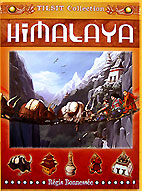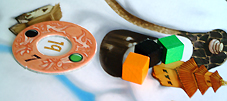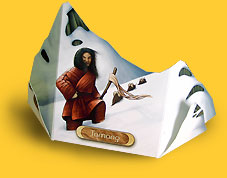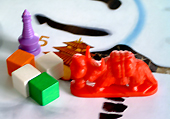Himalaya
Author: Régis Bonnessée
Publisher: Tilsit
Year: 2004
review by

| x |
|
|
|
|
|
|
|
|
|
|
|
|
|
|
|
|
|
|
|
|
|
|
|
|
|
|
 |
|
The chiefs of the Himalayan high plateau tribes have a difficult task: it’s their responsibility to supply the population of the villages with goods. Because no reliable roads are available in that area, they are forced to travel the snowy mountains with a yack’s caravan. Of course the chiefs are not only acting out of sheer charity. During their travels they attempt to exert their influence in the villages they pass on religious, political and economical matters. Three or four players each take control of a caravan and try to become the most prosperous caravaneer in the Himalaya. The board is divided into eight regions with 20 villages. There are villages of level one (a house), level two (a temple) and level three (a monastery). The villages are connected by roads, also available in three flavors: dirt track, ice track and stone track. In addition there are five different types of goods in increasing value: salt, barley, tea, jade and gold.
|
| x |
|
|
|
|
|
|
|
|
|
|
|
|
|
|
|
|
|
|
|
|
|
|
|
|
|
|
| By rolling a 20-sided die, five villages are selected where five goods are placed, randomly drawn from the bag. These are the goods that can be collected in these villages during the game. In the same way five villages are appointed where an order-ring is placed. The order-ring shows which goods are needed by the inhabitants. During the game, the players buy goods from one village and deliver them to another village where these goods are needed, and of course they are rewarded generously for their efforts by the grateful villagers. |
|
 |
| x |
|
|
|
|
|
|
|
|
|
|
|
|
|
|
|
|
|
|
|
|
|
|
|
|
|
|
 |
|
Each turn the players perform six actions that they secretly plan in advance behind their screen. The actions are depicted by six square action markers; each of the four sides depicts one possible action. The players place their markers so that the side depicting the desired action faces up. The possibilities are: moving over a dirt track, moving over an ice track, moving over a stone track and making a deal. A fifth option is taking a rest; the action marker is then placed upside down.
 |
| x |
|
|
|
|
|
|
|
|
|
|
|
|
|
|
|
|
|
|
|
|
|
|
|
|
|
|
| When all players have determined their actions, the screens are removed and the actions are carried out. First, the starting player performs his first action, then the other players, subsequently the starting player carries out his second action, again followed by the other players and so on. With the movement actions the players travel over the board, and with the deal-action they can collect goods or complete orders. Only one good can be collected in a village per turn, and that has to be the good with the lowest value. Otherwise the locals will be offended by your greediness! Therefore it can be useful to ‘take a rest’ in a village before collecting a good, and let other players collect the goods with low values first! |
|
 |
| x |
|
|
|
|
|
|
|
|
|
|
|
|
|
|
|
|
|
|
|
|
|
|
|
|
|
|
| x |
|
|
|
|
|
|
|
|
|
|
|
|
|
|
|
|
|
|
|
|
|
|
|
|
|
|
 |
|
|
|
|
|
|
|
|
|
|
|
|
|
|
|
|
|
|
|
|
|
|
 |
|
|
|
|
|
|
|
|
|
|
|
|
|
|
|
|
|
|
|
|
|
|
 |
|
|
|
|
|
|
|
|
|
|
|
|
|
|
|
|
|
|
|
|
|
|
| x |
|
|
|
|
|
|
|
|
|
|
|
|
|
|
|
|
|
|
|
|
|
|
|
|
|
|
 |
|
|
|
|
|
|
|
|
|
|
|
|
|
|
|
|
 |
|
|
|
|
|
|
|
|
|
|
|
|
|
|
|
|
|